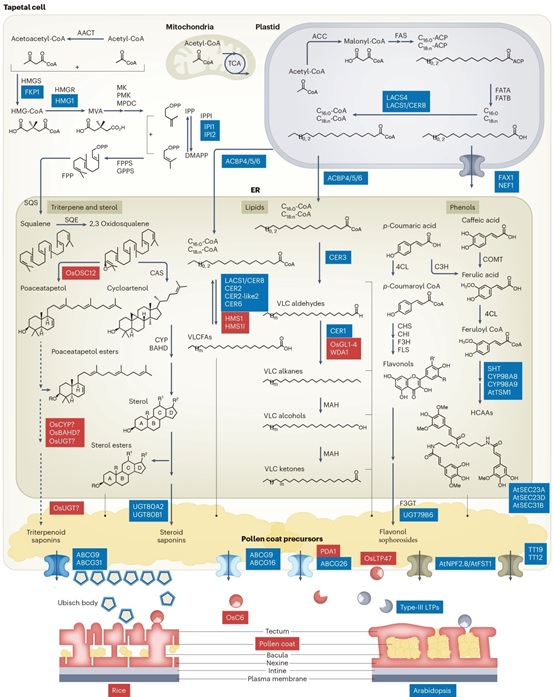Researchers from Prof. Qi' Xiaoquan’s group from Institute of Botany of the Chinese Academy of Sciences (IBCAS) have systematically illustrated that the biosynthesis and transport of the pollen coat are complex processes, involving compartmentalized biosynthesis, coordinated transport, and precise regulation between organelles and cell types. This review was published online in Nature Plants on May 25, 2023.
In the previous research of Prof. Qi Xiaoquan's group, researchers found that a tapetum-specific triterpene metabolic pathway regulated the pollen coat formation in Poaceae, and the lost-of-function mutation of OsOSC12, a key enzyme for biosynthesis of triterpene, led to the humidity-sensitive genic male sterility (HGMS).
Study on the pollen coat formation mechanism can reveal not only the basic scientific question of important reproductive organs formation, but also the genetic and molecular mechanisms of HGMS, providing valuable male sterile lines and theoretical basis for the utilization of crop heterosis.
In this review, researchers made a detailed comparison of the morphology, composition, and function of pollen coat among plant species with different pollination types, they found that the morphology and composition of pollen coat are related to pollination modes of different plant species with clear lineage specificity. Pollen coat proteins and small molecules, including long and very long chain fatty acids and their derivatives, are important pollen coat components.
Researchers summarized the genes and coding proteins involved in the biosynthesis of pollen coat precursors, and confirmed that they are mainly involved in the metabolisms of lipid, phenol, triterpene and sterol in the middle and late stages of anther development. Among them, the triterpene and sterol metabolisms vary widely in different species, indicating possible lineage specificity.
Researchers compared the processes of tapetum degradation with pollen wall formation between monocotyledons and dicotyledons at the cellular level with special attention to the morphological changes of two oil-enriched organelles at the late anther development stage.
They also discussed several urgent scientific questions. For example, what are the exact components of pollen coat? How are the pollen coat precursors synthesized and transported? And how are the biosynthesis and transport of pollen coat precursors coordinately regulated during anther development? These issues will be addressed with improvements in methods such as extensive plant genome mining, single cell and spatial multiomics, and tracing of pollen coat proteins and metabolites.
At the end, the application pollen coat-defective mutants with HGMS in crop heterosis utilization was discussed. HGMS lines could be used as a male sterile female parent to produce hybrid seeds in dry areas (such as Xinjiang, China), and propagated by self-pollinationin humid and rainy areas (southern China). This would expand the geographical range of two-line hybrid seed production, making extensive usage of crop heterosis for crop production.

A diagram of the biosynthesis and transport of pollen coat formation in monocotyledons and dicotyledons.
Article link: https://doi.org/10.1038/s41477-023-01413-0
Contact: Prof. Qi Xiaoquan, xqi@ibcas.ac.cn;
the Institute of Botany, Chinese Academy of Sciences
Researchers from Prof. Qi' Xiaoquan’s group from Institute of Botany of the Chinese Academy of Sciences (IBCAS) have systematically illustrated that the biosynthesis and transport of the pollen coat are complex processes, involving compartmentalized biosynthesis, coordinated transport, and precise regulation between organelles and cell types. This review was published online in Nature Plants on May 25, 2023.
In the previous research of Prof. Qi Xiaoquan's group, researchers found that a tapetum-specific triterpene metabolic pathway regulated the pollen coat formation in Poaceae, and the lost-of-function mutation of OsOSC12, a key enzyme for biosynthesis of triterpene, led to the humidity-sensitive genic male sterility (HGMS).
Study on the pollen coat formation mechanism can reveal not only the basic scientific question of important reproductive organs formation, but also the genetic and molecular mechanisms of HGMS, providing valuable male sterile lines and theoretical basis for the utilization of crop heterosis.
In this review, researchers made a detailed comparison of the morphology, composition, and function of pollen coat among plant species with different pollination types, they found that the morphology and composition of pollen coat are related to pollination modes of different plant species with clear lineage specificity. Pollen coat proteins and small molecules, including long and very long chain fatty acids and their derivatives, are important pollen coat components.
Researchers summarized the genes and coding proteins involved in the biosynthesis of pollen coat precursors, and confirmed that they are mainly involved in the metabolisms of lipid, phenol, triterpene and sterol in the middle and late stages of anther development. Among them, the triterpene and sterol metabolisms vary widely in different species, indicating possible lineage specificity.
Researchers compared the processes of tapetum degradation with pollen wall formation between monocotyledons and dicotyledons at the cellular level with special attention to the morphological changes of two oil-enriched organelles at the late anther development stage.
They also discussed several urgent scientific questions. For example, what are the exact components of pollen coat? How are the pollen coat precursors synthesized and transported? And how are the biosynthesis and transport of pollen coat precursors coordinately regulated during anther development? These issues will be addressed with improvements in methods such as extensive plant genome mining, single cell and spatial multiomics, and tracing of pollen coat proteins and metabolites.
At the end, the application pollen coat-defective mutants with HGMS in crop heterosis utilization was discussed. HGMS lines could be used as a male sterile female parent to produce hybrid seeds in dry areas (such as Xinjiang, China), and propagated by self-pollinationin humid and rainy areas (southern China). This would expand the geographical range of two-line hybrid seed production, making extensive usage of crop heterosis for crop production.

A diagram of the biosynthesis and transport of pollen coat formation in monocotyledons and dicotyledons.
Article link: https://doi.org/10.1038/s41477-023-01413-0
Contact: Prof. Qi Xiaoquan, xqi@ibcas.ac.cn;
the Institute of Botany, Chinese Academy of Sciences
